Cat Vomit Color Chart – What Do The Colors Mean
If you have a feline friend in your home, they will likely experience an upset stomach at some point throughout their life.
You may find yourself stumbling upon a pile of vomit, each of which can vary in terms of texture and color.
So can the color of your cat’s vomit offer any clues into the cause of their sudden nausea?
In this article we will discuss some of the most common causes of vomiting in our feline companions, and help you better understand the potential meanings behind your cat’s vomit color.

Is It Vomit Or A Hairball?
Before we discuss the many colors of vomit your cat may produce, it’s important to answer one common question; is it a hairball or vomit?
The action of producing a hairball can look very similar to vomit production, and some hairballs may even be accompanied by stomach fluids.
Because of this, it can be challenging for cat owners to differentiate between the two.
When a cat is expelling a hairball, the product will typically be a slender or cylindrical accumulation of cat hair.
There may be some liquid in the hairball, but the large majority of the material will be cat hair that was consumed during grooming.
They may crouch over and hack similarly to other vomiting cats, but the result will be a tube-like structure of hair.
As long as most of the material is made of cat hair, it’s safe to say that it’s a hairball.
Another clue that can help you differentiate between vomiting and hairballs are any other signs of GI upset.
A vomiting cat will typically display other symptoms of nausea, ranging from a decreased appetite to lethargy.
Hairballs do not typically make a cat feel ill.
Signs Of Nausea In Cats
Just like you and I, our cats can experience an upset stomach from time to time.
Some cat owners will catch their feline friend in the act of vomiting, while others will simply stumble across an unknown pile of liquid in their home.
Aside from finding the vomit itself, there are other symptoms to be on the lookout for if you think your cat may be experiencing nausea.
Some of the most common symptoms of nausea and vomiting in cats include:
- Decreased appetite or anorexia
- Increased salivation or drooling
- Licking their lips
- Repetitive swallowing
- Lethargy
- Abdominal pain
- Hiding away
- Appearing anxious or on edge
- Diarrhea
If you notice any of the above symptoms in your feline friend, they may be experiencing some form of GI upset.
There are an array of medical conditions that can lead to nausea and vomiting in cats, so we always suggest having them seen by your veterinarian for further guidance.
Why Is My Cat Vomiting?

As we mentioned above, the feline companions in our life can vomit due to a variety of underlying medical conditions.
Many factors can cause an upset stomach in cats, ranging from changes in diet to infectious illness exposure.
To help you better understand the potential cause of your cat’s vomiting, let’s briefly discuss some of the most common factors below.
Change In Diet
A sudden change in diet can cause a disturbance in the gut flora present in a cat’s digestive tract.
This sudden shift can cause significant irritation as a result, leading to an array of GI symptoms to follow.
This is why it is so important to transition your cat to a new diet over a 1-2 week period.
Bacterial Infections
Just like humans, cats can be exposed to bacteria in the world around them.
If this bacteria makes its way into your cat’s digestive tract, this can easily lead to a bacterial infection within the gut.
Once the bacteria has the opportunity to wreak havoc in the intestines, GI symptoms will typically develop.
Intestinal Parasites
Intestinal parasites can cause significant GI upset for the cat affected.
Parasites can cling to the intestinal lining as they reproduce, with some even sucking blood from the surrounding vessels.
A severe parasitic infection can cause significant GI upset, with some cats even presenting with nausea and vomiting.
Foreign Bodies
The term foreign body refers to the presence of abnormal material or objects in the digestive tract.
This typically occurs when a cat eats something they shouldn’t, causing it to become lodged in the stomach or intestines as it attempts to pass.
Because the body is not able to break down the foreign body, this often leads to a blockage.
When a blockage is present, many cats will experience vomiting.
Pancreatitis
Pancreatitis is an inflammatory condition of the pancreas that typically develops after consumption of fatty or unfamiliar food items.
This not only causes inflammation of the pancreas, but it can lead to the leaking of digestive fluids into the surrounding areas.
Not only is pancreatitis extremely painful, but it can be fatal when left untreated.
Metabolic Illness
Multiple forms of metabolic illness can lead to the onset of nausea and vomiting.
Some of the most common diseases linked to vomiting in cats include diabetes, kidney disease, hyperthyroidism, GI conditions, and cancer.
Now that you have a better idea of what could be causing your cat’s vomiting, let’s get into the different types and colors of vomit you may see in your feline friend.
Cat Vomit Types
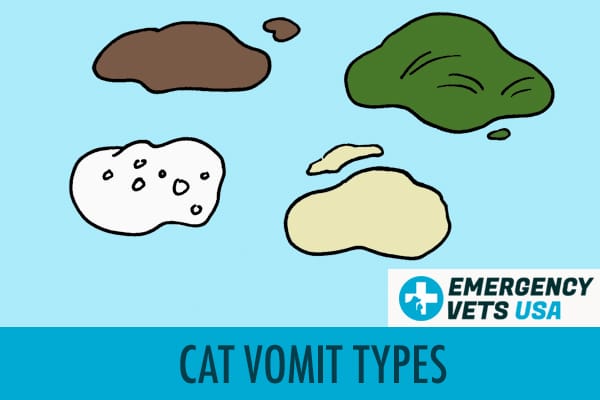
Cats can prudence vomit that comes in an array of different textures and appearances.
While some piles of vomit may be chunky and filled with food, other types of vomit may be liquid and foamy.
Before we dive into the details of our cat vomit color guide, let’s break down the different cat vomit types.
Chunky Cat Vomit
When a cat expels chunky vomit, this typically means there is food present in their vomit.
The texture of this vomit can range based on how long ago they consumed food, with consistency ranging from that of oatmeal to the presence of entire kibbles.
This may be evidence that they have vomited before they have the chance to digest their most recent meal, or they could even be vomiting as a result of something they ate.
This can also point to the potential of an intestinal blockage, as their consumed food is unable to move through the digestive tract.
Liquid Cat Vomit
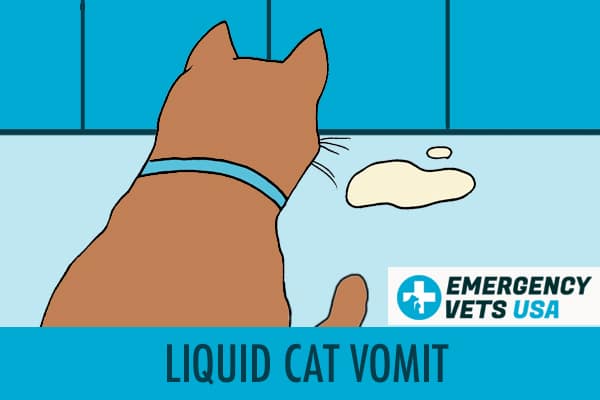
When a cat vomits liquid, this typically means that they do not have any food in their stomach at the time of their vomiting episode.
While every case will vary, this can be a bit more concerning in some situations.
If a cat vomits on an empty stomach, this typically eliminates the possibility that they are vomiting as a result of something they just ate.
This can mean that your cat is nauseous in spite of their stomach being empty, often pointing to the potential of underlying illness.
Foreign Material Cat Vomit
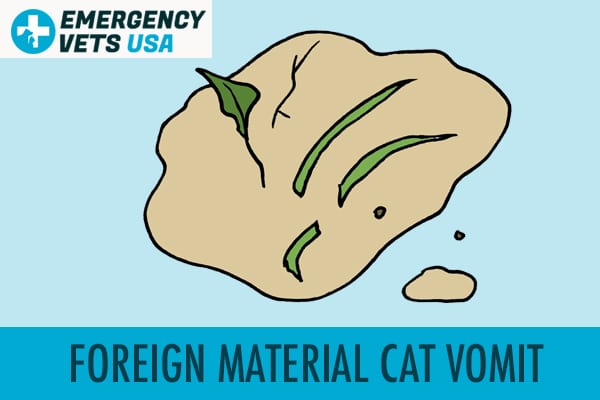
If your cat is known to eat things they shouldn’t, you may see evidence of this in their vomit.
Some cats will vomit up items ranging from hair ties to candy wrappers, all of which can lead nausea as they attempt to pass.
While some cats will get lucky and vomit up all the foreign material they consumed, this is not always the case.
Foamy Cat Vomit
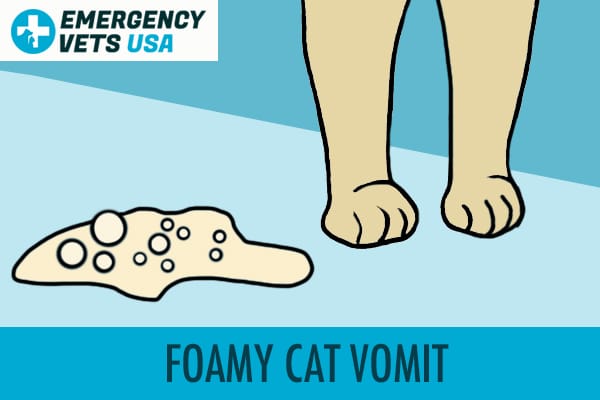
No matter the type of vomit your cat produces, there is always a possibility that foam can be present.
While some cat owners will be startled at the presence of a white froth on their cat’s vomit, this does not make a situation any more concerning.
Foam can be present in vomit when air is pushed throughout the mouth during the vomiting process.
Most cats will retch and swallow as they attempt to expel the material, causing air to move back and forth.
If there is foam in your cat’s vomit, this does not make the situation any more severe.
Cat Vomit Color
Just as your cat’s vomit texture can point to certain suspicions, so can the color of their vomit.
Though the color of your cat’s vomit can not offer a concrete diagnosis, it can help your veterinarian choose the best diagnostic tools for your feline friend.
To help you better understand the shades of vomit you may see on your carpet, let’s break down our cat vomit color chart.
Brown Cat Vomit
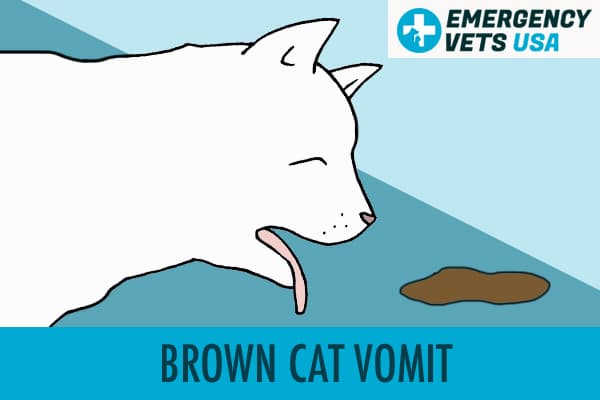
Brown cat vomit can be an indicator of a few different things in our feline friends.
First, it’s important to consider the color of your cat’s food.
Many cat kibbles are brown in color, so this could simply be a result of the dye staining their vomit.
Many cat treats are brown as well, so this could cause a brown shade of vomit if they become sick soon after eating.
Another possible cause of brown vomit is the potential for small traces of blood being present in the vomit.
Irritation within any portion of the digestive tract can cause minor bleeding, ranging in severity based on the underlying cause.
This is why we always recommend cleaning up any vomit with a white paper towel, as this can reveal any blood that may be present.
Dark rags or colored cleaning supplies can make it challenging to decipher.
Green Cat Vomit
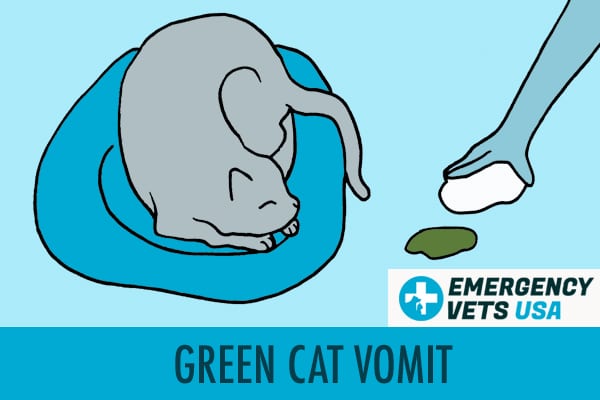
If your cat is passing green vomit, this could point to a couple different factors.
First, it’s very possible that your cat consumed some form of plant material.
Cats like to munch on plants at every given opportunity, whether it is in the grass in your yard or the house plant on your shelf.
If your feline friend has access to either of these options, that is always something you should consider.
However, even if you do think some type of plant is responsible for their green vomit, this does not mean they are in the clear.
Some plants and flowers can be extremely toxic to cats, and vomiting is one of the main signs of potential toxicity.
Because of this, it’s important to be aware of the types of plants your cat has access to.
And last, green cat vomit can be an indicator of bile present.
This can happen when a cat vomits on an empty stomach, whether they are ill or simply have a case of acid reflux.
Yellow Cat Vomit

Similar to green cat vomit, yellow cat vomit can also point to the presence of stomach bile.
This typically points to the fact that your cat is vomiting on an empty stomach, and that they are not likely vomiting as a result of something they just ate.
Red Cat Vomit
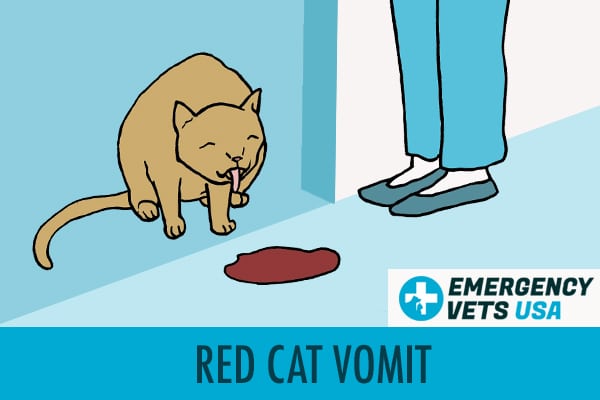
Red cat vomit is always something that should raise concern in a pet owner.
Red tinged vomit can point to the possibility of bleeding in the digestive tract, often as a result of severe irritation of the stomach or intestinal lining.
Bleeding in the gut is not only a serious medical complication in our feline friends, but it can even be life threatening if it’s left untreated.
While red vomit can be evidence of blood present in the vomit, it can also be a result of dye in their kibble.
Many pet kibbles contain red or orange dye, some of which can cause the vomit to have a red appearance when it is expelled.
This is why it is so important to clean any vomit with a white paper towel, as it is easier to examine the vomit for any trace of blood or bloody mucus.
If you are still unable to tell if any blood is present in the vomit, you can always bring a sample of the vomit into your vet’s office.
Black Cat Vomit

Black vomit in cats is another daunting vomit color that should always be taken seriously.
Black vomit can develop as a result of digested blood in the GI tract, often having a coffee ground-like appearance.
Not only can the presence of black cat vomit point to a serious complication within their digestive tract, but it can be fatal if left untreated.
If you ever see any evidence of black vomit in your feline friend, we suggest contacting your veterinarian immediately.
White Cat Vomit
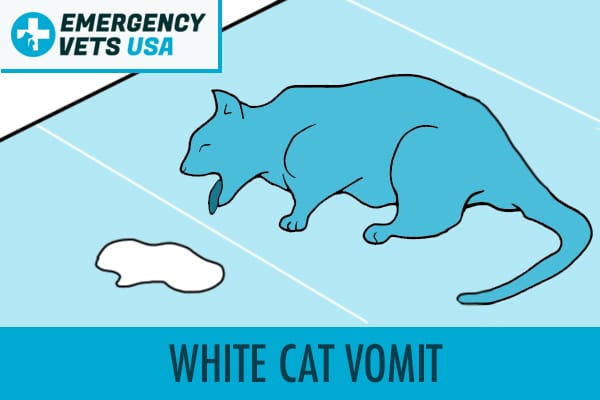
When you stumble upon a pile of white cat vomit, this typically means that there is foam present in the vomit.
As we mentioned above, foam can develop as a result of air flow in the mouth during vomit production, causing the vomit to bubble up when it exits the body.
The presence of foam in your cat’s vomit does not make it any more serious, but you do tend to see more of it when a cat is vomiting on an empty stomach.
When Should You See The Vet?
If your feline companion is suddenly experiencing an upset stomach, you may wonder when it is time to have them seen by your veterinarian.
Some cats may only vomit once without the onset of any other GI symptoms, while others will become more ill as time passes.
To help you better determine when you should seek veterinary guidance, let’s list a few basic health care rules.
If your cat only vomits once and is acting fine otherwise, it is okay to wait on the vet visit and monitor them closely at home.
If their GI upset resolves within 12 hours and they do not have another vomiting spell, then it’s possible that they simply had a mild case of an upset stomach.
However, if they vomit more than once or have developed any other concerning symptoms outside of their vomiting, they should always be seen by a vet.
Another factor to consider is whether or not they have any underlying medical conditions.
If your cat has been diagnosed with a chronic illness, or if they are prone to episodes of GI upset, we always suggest seeking veterinary care at the first sign of vomiting.
At the end of the day, it is never a bad idea to reach out to your vet for guidance when your cat begins to vomit.
They know your furry friend’s medical history, so they can help you determine the best plan of action for your cat.
Final Thoughts
While the color of your cat’s vomit is not a diagnosis by any means, it can potentially offer clues as to what is occurring within their digestive tract.
Not every case of vomiting will point to serious illness in our feline friends, but it’s always best to reach out to your veterinarian just in case.

My name is Amber. I am a dedicated animal lover that turned my passion into my career. I am a Licensed Vet Tech with 12 years of experience in veterinary medicine, but I recently took my career online to help spread accurate information on animal care. With how vast the online world is, I have a strong desire to ensure that the reader always walks away with helpful pet advice. With the experience I’ve gained from my time in this field, I have been able to travel the world, offering my services to as many animal rescues as I can find. If I am not at my laptop, or back home visiting family, you can find me somewhere in the world, cuddling every furry friend that I can find! More About Us
